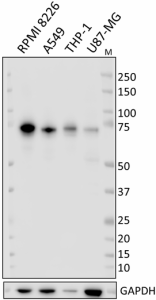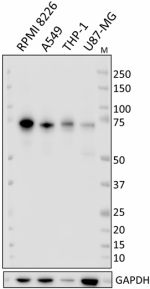- Clone
- O91E1 (See other available formats)
- Regulatory Status
- RUO
- Other Names
- SRB1, SR-B1, SRBI, CLA-1, CLA1, HDLQTL6
- Isotype
- Mouse IgG2b, κ
- Ave. Rating
- Submit a Review
- Product Citations
- publications

-

Total cell lysates (15 µg total protein) from RPMI 8226, A549, THP-1, and U87-MG cells were resolved by 4-12% Bis-Tris gel electrophoresis, transferred to a nitrocellulose membrane, and probed with 1.0 µg/mL (1:500 dilution) of Purified anti-CD36L1(SCARB1, SR-BI) Antibody, clone O91E1, overnight at 4°C. Proteins were visualized by chemiluminescence detection using HRP goat anti-mouse IgG Antibody (Cat. No. 405306) at a 1:3000 dilution. Direct-Blot™ HRP anti-GAPDH Antibody (Cat. No. 607904) was used as a loading control at a 1:50000 dilution (lower). Lane M: Molecular Weight marker. Cell lysates were loaded in descending of predicted CD36L1 expression; predicted expression data was obtained from Human Protein Atlas.
| Cat # | Size | Price | Quantity Check Availability | Save | ||
|---|---|---|---|---|---|---|
| 678702 | 100 µg | 268€ | ||||
Scavenger receptor class B type I (SCARB1), also known as CD36L1, is an integral membrane protein found in numerous cell types and tissues including the liver and the adrenal glands. Its primary function is to facilitate the uptake of cholesteryl esters from high-density lipoproteins (HDL) due to its high affinity to HDL. This function serves to lower the risk of development of atherosclerosis. SCARB1 is also able to bind to other lipoproteins such as LDL, OxLDL, and VLDL. SCARB1 is also likely to be involved in pathogen recognition through its recognition of mycobacteria and other viral proteins and regulates vitamin E levels in the tissue.
Product DetailsProduct Details
- Verified Reactivity
- Human
- Antibody Type
- Monoclonal
- Host Species
- Mouse
- Immunogen
- Full length recombinant human SCARB1 protein produced in HEK293T cells.
- Formulation
- Phosphate-buffered solution, pH 7.2, containing 0.09% sodium azide.
- Preparation
- The antibody was purified by affinity chromatography.
- Concentration
- 0.5 mg/ml
- Storage & Handling
- The antibody solution should be stored undiluted between 2°C and 8°C.
- Application
-
WB - Quality tested
- Recommended Usage
-
Each lot of this antibody is quality control tested by Western blotting. For Western blotting, the suggested use of this reagent is 0.5 - 2.0 µg per ml. It is recommended that the reagent be titrated for optimal performance for each application.
- RRID
-
AB_2566049 (BioLegend Cat. No. 678702)
Antigen Details
- Structure
- Different isoforms with a predicted molecular weight of approximately 60 kD to 80 kD. Integral membrane glycoprotein.
- Distribution
-
Macrophages, hepatocytes, dendritic cells, adrenocortical cells, adipocytes, and trophoblastic cells.
- Function
- Involved in the uptake of high density lipoproteins (HDL), phagocytosis of apoptotic cells, and pathogen recognition. Receptor target of the hepatitis C virus.
- Interaction
- HCV E1/E2 and PDZK1.
- Ligand/Receptor
- Phosphatidylserine, HDL, apoB-containing lipoproteins, LDL, and vitamin E.
- Cell Type
- Dendritic cells, Macrophages
- Biology Area
- Apoptosis/Tumor Suppressors/Cell Death, Cell Biology, Immunology, Innate Immunity, Signal Transduction
- Antigen References
-
1. Acton S, et al. 1996. Science 5248:518.
2. Rigotti A, et al. 2003. Endocr. Rev. 24:357.
3. Valacchi G, et al. 2011. Ann. NY Acad. Sci. 1229:E1.
4. Scarselli E, et al. 2002. EMBO J. 21:5017.
5. Mardones P, et al. 2002. J. Nutr. 132:443. - Gene ID
- 949 View all products for this Gene ID
- UniProt
- View information about CD36L1 on UniProt.org
Related Pages & Pathways
Pages
Related FAQs
Other Formats
View All CD36L1 Reagents Request Custom Conjugation| Description | Clone | Applications |
|---|---|---|
| Purified anti-CD36L1 (SCARB1, SR-BI) | O91E1 | WB |
Compare Data Across All Formats
This data display is provided for general comparisons between formats.
Your actual data may vary due to variations in samples, target cells, instruments and their settings, staining conditions, and other factors.
If you need assistance with selecting the best format contact our expert technical support team.
-
Purified anti-CD36L1 (SCARB1, SR-BI)

Total cell lysates (15 µg total protein) from RPMI 8226, A54...
 Login / Register
Login / Register 







Follow Us